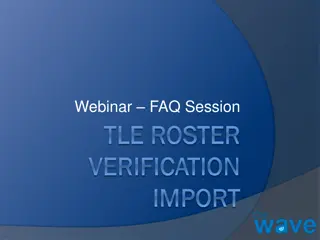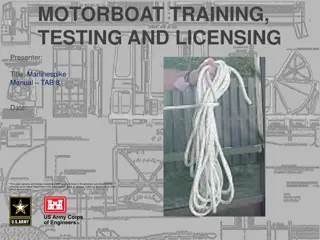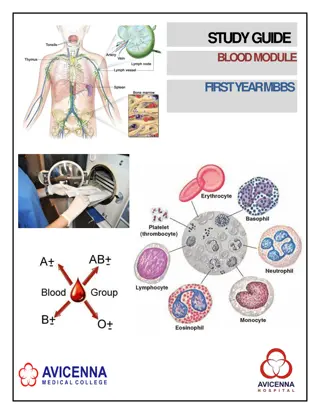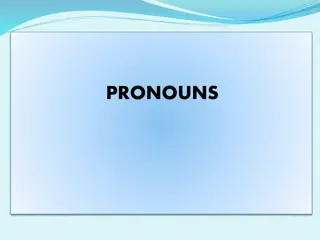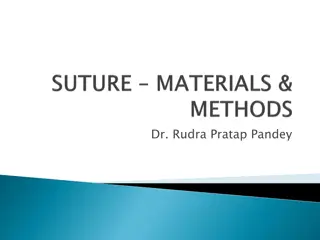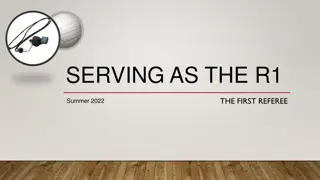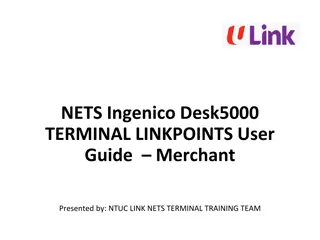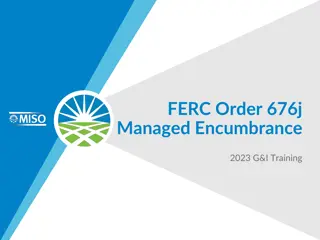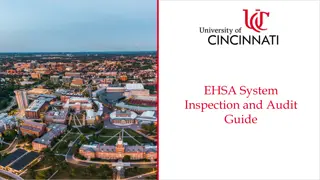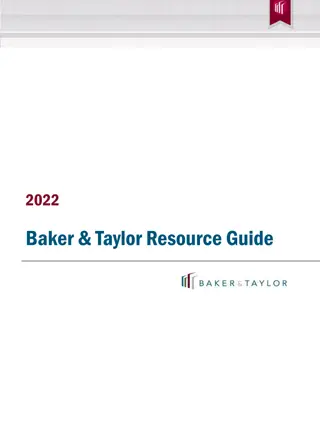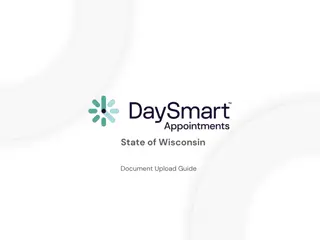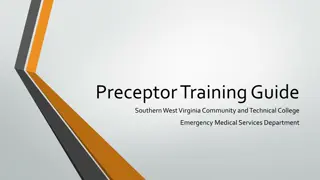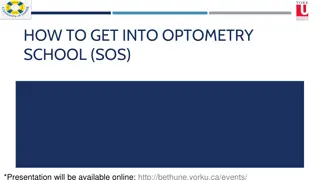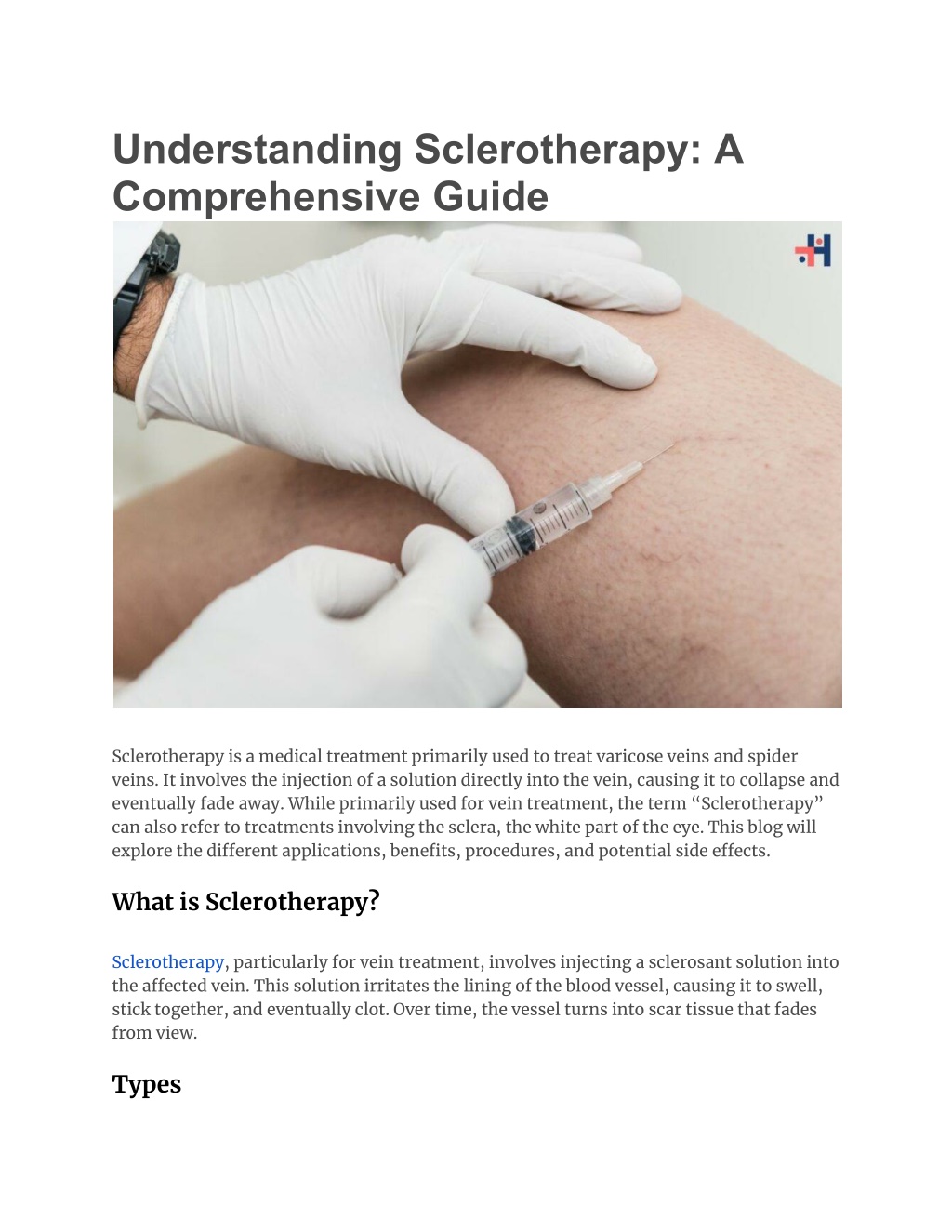
Understanding Sclerotherapy_ A Guide
Sclerotherapy is a medical treatment primarily used to treat varicose veins and spider veins.
Uploaded on | 0 Views
Download Presentation

Please find below an Image/Link to download the presentation.
The content on the website is provided AS IS for your information and personal use only. It may not be sold, licensed, or shared on other websites without obtaining consent from the author. Download presentation by click this link. If you encounter any issues during the download, it is possible that the publisher has removed the file from their server.
E N D
Presentation Transcript
Understanding Sclerotherapy: A Comprehensive Guide Sclerotherapy is a medical treatment primarily used to treat varicose veins and spider veins. It involves the injection of a solution directly into the vein, causing it to collapse and eventually fade away. While primarily used for vein treatment, the term Sclerotherapy can also refer to treatments involving the sclera, the white part of the eye. This blog will explore the di?erent applications, benefits, procedures, and potential side e?ects. What is Sclerotherapy? Sclerotherapy, particularly for vein treatment, involves injecting a sclerosant solution into the a?ected vein. This solution irritates the lining of the blood vessel, causing it to swell, stick together, and eventually clot. Over time, the vessel turns into scar tissue that fades from view. Types
1. For Veins: This is the most common form of Sclerotherapy, used to treat varicose and spider veins. 2. For the Eye: This lesser-known application involves treatments related to the sclera, such as correcting certain ocular conditions. For Veins How Does It Work? In sclerotherapy for veins, a medical professional injects a sclerosant solution into the varicose or spider vein. This solution typically contains hypertonic saline, polidocanol, or sodium tetradecyl sulfate. The injected solution causes the vein walls to stick together, blocking the flow of blood. As the vein turns into scar tissue, it eventually fades away. Procedure 1. Consultation: The first step is consulting with a healthcare provider to determine if you are a good candidate for sclerotherapy. Your medical history and the severity of the vein issues will be evaluated.
2. Preparation: On the day of the procedure, avoid applying lotion or shaving your legs. Wear loose, comfortable clothing. 3. Injection: The procedure typically takes 30 to 45 minutes. The doctor uses a fine needle to inject the sclerosant solution into the a?ected veins. 4. Post-Procedure Care: Patients are usually advised to wear compression stockings for a few weeks after the procedure to help with healing and improve results. Avoid strenuous exercise and sun exposure to the treated areas for a few days. Benefits 1. E?ectiveness: It has a high success rate for eliminating or reducing the appearance of varicose and spider veins. 2. Minimally Invasive: The procedure is minimally invasive, usually requiring no anesthesia and having a quick recovery time. 3. Improved Appearance: It can significantly improve the appearance of the legs by reducing or eliminating visible veins. 4. Pain Relief: In addition to cosmetic benefits, it can also relieve symptoms associated with varicose veins, such as aching, swelling, and burning. Potential Side E?ects While it is generally safe, there are potential side e?ects to be aware of: 1. Temporary Side E?ects: These include bruising, redness, and mild pain at the injection site. These usually resolve within a few days. 2. Serious Side E?ects: Rarely, patients may experience blood clots, severe inflammation, or allergic reactions. It s important to contact your doctor if you experience any severe or prolonged symptoms. 3. Skin Discoloration: Some patients may experience brown lines or spots at the injection site, which can take months to fade. For the Eye While less common, Sclerotherapy can also refer to treatments involving the sclera of the eye. These treatments can include procedures to correct scleral thinning or other ocular conditions. Common Ocular Conditions Treated
1. Scleral Thinning: This condition can be caused by diseases like scleritis. Treatment may involve surgical procedures to reinforce the sclera. 2. Cosmetic Scleral Procedures: These can include tattooing the sclera for cosmetic reasons, although such procedures are controversial and not widely recommended. Procedure Scleral treatments for the eye are typically more complex and may involve surgical intervention. The specifics of the procedure will depend on the condition being treated and the individual patient s needs. Post-Procedure Care For Vein 1. Compression Stockings: Wearing compression stockings helps reduce swelling and improves blood flow in the treated area.
2. Avoid Sun Exposure: Protect the treated area from sun exposure to prevent discoloration. 3. Avoid Strenuous Activity: Refrain from intense physical activities for a few days after the procedure. For Ocular Post-procedure care will depend on the specific treatment performed. It may include: 1. Medication: Eye drops or other medications to reduce inflammation and prevent infection. 2. Follow-Up Visits: Regular check-ups with your eye doctor to monitor healing and ensure the success of the treatment. Who is a Good Candidate? Vein
1. Adults with Varicose or Spider Veins: Ideal candidates are those who have varicose or spider veins that cause discomfort or cosmetic concerns. 2. Non-Pregnant Individuals: Pregnant women are usually advised to wait until after delivery to undergo sclerotherapy. 3. Good Health: Candidates should be in generally good health, without severe heart conditions or allergies to the sclerosant solution. Ocular Candidates for ocular Sclerotherapy will be determined based on the specific condition being treated. A thorough examination by an eye specialist is required to determine eligibility. Total Cost The cost of sclerotherapy can vary widely depending on factors such as the location of the clinic, the severity of the vein issues, and the number of sessions required. On average, the cost ranges from $300 to $500 per session. Insurance coverage may vary, so it s important to check with your provider. Choosing the Right Provider Selecting a qualified and experienced healthcare provider is crucial for the success. Consider the following: 1. Credentials and Experience: Ensure the provider is board-certified and has extensive experience in performing. 2. Patient Reviews: Look for reviews and testimonials from previous patients to gauge their satisfaction with the provider s services. 3. Consultation: Schedule a consultation to discuss your concerns, ask questions, and determine if you feel comfortable with the provider. Conclusion Sclerotherapy, whether for treating varicose veins or certain ocular conditions, o?ers a minimally invasive solution with a high success rate. By understanding the procedure, benefits, potential side e?ects, and post-procedure care, patients can make informed decisions about their treatment options. Always consult with a qualified healthcare provider to determine if Sclerotherapy is the right choice for you and to ensure the best possible outcome.
Find practical solutions to common challenges through our insightful articles on Healthcare 360 Magazine





